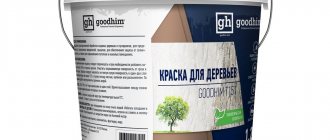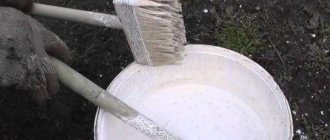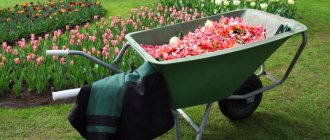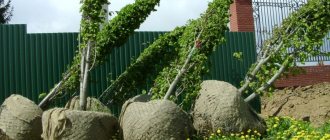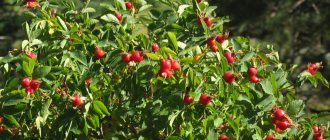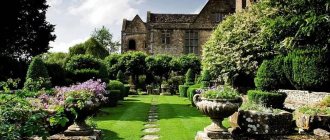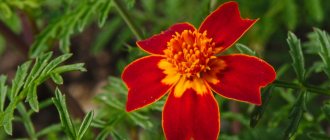Tree paint is a special mixture that is used to coat tree trunks and shrubs to protect them from weather conditions and harmful insects. Unlike whitewashing, it does not require additional components or a lengthy preparation process. Preparing lime requires auxiliary manipulations and is accompanied by the likelihood of injury when slaking it. Precautions and protective items against splashes and burns will be required.
There are no such difficulties with paint. The container contains a ready-made product that must be diluted with water if it is too viscous. In this case, the amount of liquid should not exceed 5% of the total volume of paint. When applied, it forms a thin film through which air can pass. This keeps the tree's metabolic processes unchanged, but prevents the harmful effects of parasites, insects and bacteria.
Types of paints for processing
There are several types of paints, differing in the base and components included:
- Water-based paint. Prevents the destruction of the bark due to temperature changes and protects from exposure to sunlight. The most widespread is the acrylic variety, where the binding component is acrylic resins. Silicone paint is not recommended for use on trees, as it creates an airtight layer, disrupting the normal development of the tree. The acrylic water-based mixture does not contain components that protect against pests, so ingredients containing copper are added to it. This prevents parasites from getting under the bark. When choosing a product, you should pay attention to the presence of the mark “for garden trees” and not confuse it with oil paint, which has an extremely negative effect on living plants. The water-based composition is applied in the warm season on a calm, clear day. The content of antifungal and antiseptic components inhibits rotting and the spread of bacteria;
- Water-dispersed. The composition includes an antiseptic that protects the trunks from parasites; white pigment that prevents destruction by ultraviolet radiation; latex, which provides a durable coating. Unlike water-based, it contains components that repel rodents and insects. Both types of paint have one minor drawback: the air temperature when painting should be above 7° C. When choosing water-dispersion paint, you should make sure that it is acrylic. This will ensure its increased resistance under the influence of precipitation;
- Alkyd. The binding element of the composition is alkyd resins. Due to its resistance to weathering and mechanical damage, this variety is becoming increasingly widespread. It is quick-drying and does not have a strong odor. The resulting film repels moisture, protecting the bark from rotting and icing. The advantages of alkyd-based coatings are low cost, high protective properties and an excellent level of frost resistance;
- Aerosol. The new item, which has appeared in the summer cottage assortment, deserves attention for its practicality. It is an aerosol can with garden whitewash inside. It has the same protective properties as the liquid mixture, protecting the tree trunk from temperature influences, insects and parasites. Convenient for use in hard-to-reach areas, nodes on the trunk and junctions of branches. Sprays from a distance of 30 cm from a pre-shaken can. Apply a thin layer and fill even the smallest cracks in the bark. A small disadvantage is the use at air temperatures above 10° C.
Despite the differences, all types of paints are more convenient to use than traditional slaked lime; they are easy to apply and effectively protect the trunks of trees and shrubs.
Perfect time
It is best to start whitening trees in late February or early March. During this period, the trunks warm up to +11 ºC, so there is a risk of the formation of early sap movement. In spring, night temperatures are still too low. Often the thermometer readings drop below -11 ºC. At such indicators, the juice can freeze and tear the trunk tissue from the inside.
When this happens, frost holes form. Experts, talking about why tree trunks are whitened in the spring, draw attention to the fact that white paint can repel the sun's rays. In this way, the juice is prevented from moving earlier. Fruit and ornamental crops wake up later, on time, when it is completely safe for them.
Frost holes on tree branches Source hozyain.by
Purpose
By application:
- Protection from rodents. The death of trees and shrubs is often caused by small rodents, such as voles or water rats, and hares. By eating the bark, they injure the tree, leaving it without protection. The special components included in the paint repel pests and prevent them from damaging the trunks;
- Reflection of ultraviolet rays. When exposed to the sun, trunks that are not covered with protective paint receive burns and cracks, which serve as an entry point for insects. The white color reflects the rays, so the barrel is reliably protected from overheating and cracking;
- Protection from temperature changes. Winter time is dangerous because there is strong heating during the day and sharp cooling at night. Such temperature fluctuations destroy the unprotected surface, opening access to pathogenic microbes. It prevents the destruction of the trunk, protecting it from frost;
- Destruction of harmful insects and bacteria. Trees often become a refuge for insects in the winter, so the paint includes an antiseptic that can destroy colonies of fungi, microorganisms and pests and preserve the health and beauty of the trunks;
Pests
- Protection from moisture and rot. If, due to an oversight, cracking of the bark does occur, then the paint layer will protect the trunk from excess water and prevent rotting of the surface;
- Healing. When pruning branches or cutting trunks, it is permissible to use paint instead of garden varnish, treating the unprotected surface. This will prevent rotting or fungal infection;
- Disinfection of all parts of the tree. Diluting the paint with water and spraying the crown and skeletal branches with a spray bottle will protect against the development of scab and rot diseases and neutralize the effects of acid precipitation.
Timely treatment of trunks twice a year will preserve the health and beauty of the garden, preventing the development of diseases and harmful parasites.
Whitewashing tools
Typically, gardeners use washcloths for designated purposes. But whitening them is not very convenient. It will be much easier to work with a paint brush with synthetic bristles. The maklovitsa helps to cover a large area with one movement of the hand. It is easy to work with both when the bark has a smooth structure and when the tree trunks are covered with deep cracks. If the garden is large and there are tall trees in it, it is better to whiten them with a spray gun. It will be faster and less labor intensive.
Whitewash brush Source stalevar.ua
Advantages and disadvantages
The main disadvantage of paint is its cost in relation to whitewash. Lime, even in combination with copper sulfate and clay, is a cheaper composition. But it has much worse protective properties and is also easily washed off with water. In addition, it does not have an antiseptic effect, which will require additional treatment against fungi and rotting. Another negative property of lime is the absorption of moisture from the trunk itself, which has a detrimental effect on the condition of the plants.
A special mixture with the addition of protective components helps to avoid all these unpleasant consequences. It does not harm trees and withstands the effects of water. The durability period declared by the manufacturers is 2 years for mature trees, and one year for young trees, which is associated with the growth process and expansion of the bark. The special components included in the paints provide them with plasticity and eliminate smudges during application, which are typical for lime mortars.
Optimal time of year
Where to start preparatory work for painting or whitewashing trees? First of all, you need to decide when to carry out the manipulations. The most important thing is to carry out painting on a dry and windless day. If you want to start coloring in the fall, you should wait until the end of the rainy season. If it is more convenient for you to whitewash trees in the spring, then you should carry out the procedure after warm weather sets in, when the thermometer rises above seven degrees with a plus mark.
There are a number of detailed recommendations for spring painting:
- Don't wait for the earth to warm up. This can lead to insects waking up, and then whitewashing the trees will become practically ineffective.
- If the autumn painting of tree trunks was not carried out for some reason, then spring manipulations are recommended to be carried out in two stages: in the last days of February and in mid-April.
Proper preparation and application
To obtain the desired result, it is important to know the processing time and properly prepare the trees for painting. For autumn whitewashing, it is important to wait until the end of the rainy season - this is approximately mid-autumn. Spring whitewashing is carried out with the onset of above-zero temperatures, when the air warms up to at least 5–7° C. It is advisable to choose a windless and dry day, without rain. If the autumn painting was skipped, then in the spring the trunks will need to be treated twice. The first is carried out in late February - early March, the next one is carried out in April. This will provide reliable additional protection against parasites already lurking in the bark and crown. Another significant point when choosing the processing time is the condition of the soil. It should not have time to warm up, otherwise the sleeping bugs will wake up and climb onto the trunks that were not treated in time.
Paint is applied using brushes, a roller or a spray gun. The first option is less expensive, as it implies the ability to pre-select the optimal width of the brushes in accordance with the thickness of the branches and trunk. A spray gun allows you to save time and quickly whiten trees. The roller evenly and quickly paints trees with thick trunks, and the foam surface ensures liquid penetration into every crevice. Often gardeners prefer to combine application methods.
Before painting, it is important to carry out preparatory work: using a scraper or wire brush, scrape off dead bark, dust and dirt. Clean off accumulated moss and lichens, inspect the tree for damage and cracks. If there are any, treat them with garden varnish, filling the cracks in the bark with it. Additional treatment with alkaline agents against parasites and microbes that have already penetrated the tree trunk will not be superfluous. After processing, the barrel must dry, and only then can you begin painting.
When preparing the surface, special attention should be paid to dead bark. You should take care of this in advance and spread fabric or polyethylene under the trunk, onto which dead particles will fly. Since they contain dormant insect larvae and eggs, it is important to ensure that they do not remain on the ground. At the end of preparation, take away and burn all peeled bark to prevent the spread of parasites.
The paint is applied in one layer to a height of at least one meter. The best protection would be to paint the entire trunk, plus 1/3 of the length of the lower branches. Whitewashing begins from the bottom of the trunk, gradually rising to the branches. Omissions should be avoided to ensure maximum barrier to harmful effects. Any garden paint is suitable for protecting mature trees, but acrylic paint is not recommended for young seedlings. It does not have breathing properties and can harm the development of young plants.
Why should you paint?
Caring for trees in the garden begins in early spring, when the snow barely begins to melt and the first streams flow. Just at this time, when the insects have not yet woken up and the pests have not had time to crawl out of their underground burrows, special paint should be applied to the trees. It will protect the plants from parasites, preventing them from penetrating the tree trunk. If the insects overwintered in the folds of tree bark, then the paint will prevent their further life activity.
As you can see, this method is very useful, as it protects the plant from uninvited guests, promotes its healthy appearance and an abundant, tasty harvest.
What types of protective garden paints are there and how should they be used? Let's find out.
Other uses
In addition to protecting tree trunks, it is also used to disinfect the crown. To do this, the composition is diluted with water based on the calculation of 1 kg of paint per 10 liters of water, and the branches are treated with a spray bottle. For the same purposes, bushes, hanging plants, as well as flower bulbs for flower beds are sprayed. Processing the grapes will prevent early bud break and protect against late frosts.
To protect bulbs and root vegetables from hares and small rodents, you should prepare several slats of wood and paint them with garden paint. Then stick it around the beds where rodents are encroaching. Sensing the smell emitted by special components, animals will avoid approaching the garden.
Utility and utility rooms, garden furniture and decorative wooden elements are treated to protect against sunlight. It will prevent rotting and protect against parasites, which will significantly increase its service life. Forming a protective layer that prevents the spread of insects in wooden parts of furniture. In addition, painted white, it will have a beautiful appearance. Many types of paints can be mixed with color pastes, so summer residents have a wide choice of colors for their garden furniture.
Basic rules for painting
When preparing to whitewash a garden, it is important to properly prepare the tree. The trunk of the plant must first be removed from the peeling parts of the bark, and the cracked areas must be carefully cleaned. The removed bark must be removed away from the garden and burned. It contains parasite larvae, which, after the winter awakening, can continue to destroy the plant.
Damaged areas on the trunks should be carefully treated several times. First apply the first coat of paint, then, after drying, re-treat the area. One layer of the substance is applied to regularly treated surfaces.
Autumn painting is best done after the end of the heavy rainy season. Spring manipulation - before the onset of stable warm temperatures. When the soil warms up, insect larvae become active in the plant bark, which worsens the result of its treatment.
Paint for garden trees adheres more firmly to the bark than a well-known solution; painted areas of wood will be protected all season.
Garden tree protective paint can also be used to disinfect wood cuts when pruning shoots in spring. Its antibacterial properties prevent plant infection and promote rapid healing of shoots. Some formulations in diluted form are used for spraying trees and shrubs. They help eliminate harmful parasites and pathogenic bacteria.
Paint for garden trees is applied using a brush, roller, or special sprayer. When choosing the best painting option for yourself, you should also take care of protecting your own skin. It is better to carry out manipulations with gloves and safety glasses. This minimizes the possibility of injury and damage to the skin.
How to treat a cut apple tree? Disinfection methods
Damage to an apple tree of any size must be treated with a disinfectant so that pathogens do not enter the wound.
So, what to cover a pruned apple tree with? Potassium permanganate and preparations containing copper or iron sulfate are suitable for these purposes. All solutions are prepared immediately before processing apple trees:
- 50 grams of copper sulfate are diluted in 1 liter of very warm water;
- Several grains of potassium permanganate are diluted in warm water. The color should be bright pink;
- 30 grams of iron sulfate are diluted in 1 liter of water;
- Prepare a 3% Bordeaux mixture . To do this, 30 grams of copper sulfate are dissolved in 0.5 liters of warm water. Separately, dilute 30 grams of lime in 0.5 liters of water. The vitriol solution is slowly poured into the milk of lime in a very thin stream, stirring constantly. The finished Bordeaux mixture has a beautiful blue color.
To apply the solution, use any brush. The weather at the time of processing should be dry and windless. Be sure to use rubber gloves.
To disinfect damaged wood, you can use balms with fungicides, which are sold in gardening stores.
What to do if the cut rots?
If a cut on an apple tree begins to rot, this may indicate that the tree is infected with spores of a tinder fungus. The spores are carried by the wind, and an uncovered cut is an excellent place for infection. No means have yet been invented to combat this scourge.
The branch is cut off completely and the place of the cut is checked. Healthy wood is an indicator that the disease has not yet penetrated deep into the apple tree. The diseased branch is burned, and the cut is disinfected and covered with garden varnish.
If soft dark wood , it means that the tinder fungus has taken over the entire tree, and after a while the apple tree will die. It is cut down completely and burned. If you leave it, the whole garden can become infected.
How to cover a cut on an apple tree?
After the cleaned and disinfected cut on the apple tree dries, it must be covered with a special product . This is done to seal damage to close the entrance to pests, bacteria and fungi.
In addition, in the place of an unprotected cut, the branch may begin to dry out. This happens because:
- Sap flow is disrupted, nutrients do not reach the part of the branch that is located above the damage;
- Moisture evaporates through the wound.
An unprotected wound is prone to cracking, and sometimes the cracks are deep. A hollow may form in the place where the saw cut damaged the bark of the apple tree.
The following is used as putty:
- Garden var;
- A thick mash of clay and mullein;
- Oil paints on natural drying oil;
- Cement mortar – for particularly large damages;
- Water-based paints;
- Artificial bark (balm - varnish).
Garden varnish can be purchased at the store, or you can prepare it yourself. To prepare it, wax, rosin and fat are used.
The wax does not allow water to reach the wood and does not allow the putty to drain from the wound. The stickiness of rosin allows the varnish to firmly bond to the wood. Fat prevents the putty from cracking in any weather.
Any unsalted fat is suitable. You can replace it with vegetable oil or natural drying oil. Turpentine is suitable instead of wax.
- Take 1 part each of rosin and fat, and 2 parts of wax. Rosin, wax and fat are melted separately and then mixed. This solution is slowly poured into cold water. Take out after hardening;
- Also mix 20 parts of paraffin, 4 parts of rosin and 1 part of drying oil;
- Rosin and wax 2 parts each, vegetable oil - 1;
- Rosin 1.5 parts, oil - 2. Heat, mix and pour in 1 part of turpentine. It is important to do this away from the fire.
What to do if the cut turns black (darkened) or a stain appears?
If the cut on the apple tree is not processed in time, then pathogens could settle on it. With such symptoms, apple canker and cytosporosis .
If these diseases are not treated, the disease spreads to the rest of the branch, occupying increasingly larger areas. First, individual branches will dry out, and then the entire tree. Neighboring trees may also suffer from this disease.
During treatment, all damaged parts are cut off, going onto healthy bark and wood. Treat this area with a 3% Bordeaux mixture if the leaves have not yet blossomed, or with a 1% solution if the growing season has already begun.
Let it dry a little, and then cover it with garden varnish or diluted clay. If the disease spreads further, the treatment should be repeated. It is necessary to spray not only the cut site, but the entire apple tree.
Watch the video report on apple tree cancer:
The bark of an apple tree is damaged - what to do?
The bark of the apple tree is damaged due to sunburn, temperature changes in winter, due to rodents or other mechanical damage .
Also, the bark may peel off from an old, unkempt tree. The bark on the apple tree is restored, but only if the damage is minor. If the bark is damaged along the entire circumference, the tree will dry out.
The burrs of the bark are cut off with a garden knife, and the exfoliated pieces are cleaned off with a hard brush. When working, you must try not to damage the wood. Be sure to treat with Bordeaux mixture , because there may be pest larvae under the bark.
Cover the area with a mixture of clay, mullein and ash diluted with water . For reliability, the damaged area is bandaged with natural fabric.
